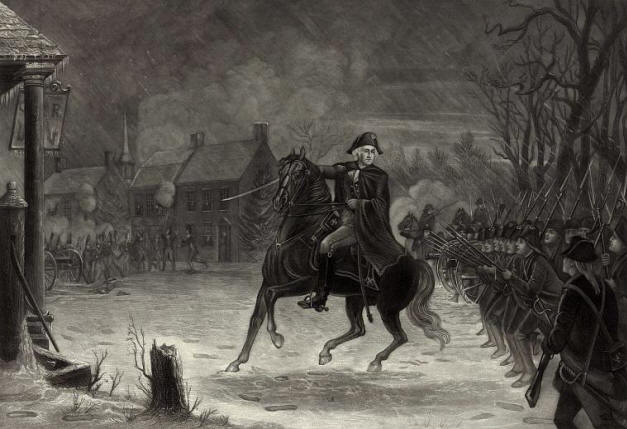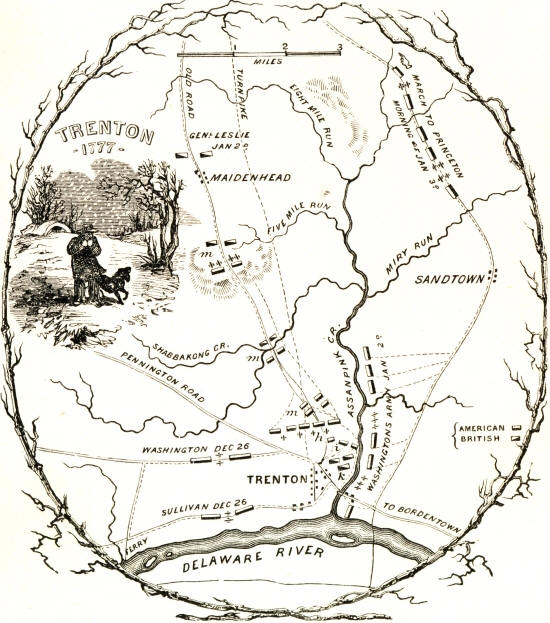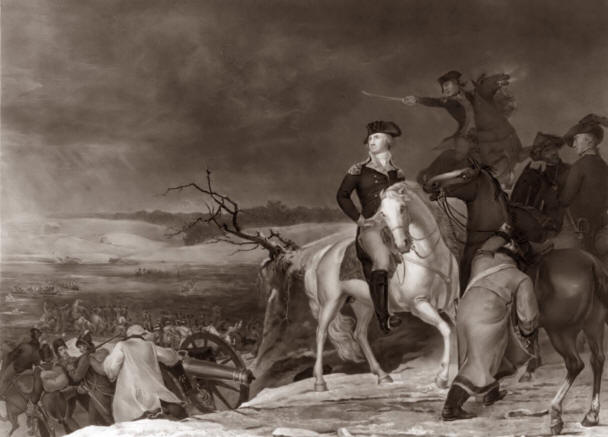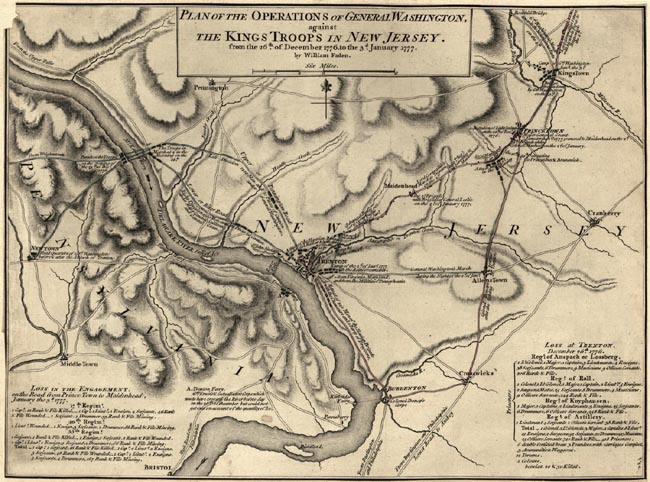Battle of Trenton
|
|
This Site:
|
George Washington at the Battle of TrentonTrenton, BATTLE OF. Late in December, 1776, Washington's army, by much exertion, had increased to nearly 6,000 men. Lee's division, under Sullivan, and some regiments from Ticonderoga under Gates, joined him on the 21st. Contrary to Washington's expectations, the British, content with having overrun the Jerseys, made no attempt to pass the Delaware, but established themselves in a line of cantonments at Trenton, Pennington, Bordentown, and Burlington. Other corps were quartered in the rear, at Princeton, New Brunswick, and Elizabethtown; and so sure was Howe that the back of the "rebellion" was broken that he gave Cornwallis leave to return to England, and he was preparing to sail when an unexpected event detained him. George Washington knew that about 1,500 of the enemy, chiefly Hessians (Germans), were stationed at Trenton under Colonel Rall, who, in his consciousness of security and contempt for the Americans, had said, "What need of entrenchments? Let the rebels come; we will at them with the bayonet." He had made the fatal mistake of not planting a single cannon.
Trenton Battle Map Washington felt strong enough to attack this force, and at twilight on Christmas night he had about 2,000 men on the shore of the Delaware at McConkey's Ferry (afterwards Taylorsville), a few miles above Trenton, preparing to cross the river. He rightly believed that the Germans, after the usual carouse of the Christmas festival, would be peculiarly exposed to a surprise, and he prepared to fall upon them before daylight on the morning of the 26th. With him were Generals Stirling, Greene, Sullivan, Mercer, Stephen, and Knox, commanding the artillery. Arrangements were made for a similar movement against the cantonments below Trenton, the command of which was assigned to General Gates; but that officer, jealous of Washington, and in imitation of General Lee, with willful disobedience refused the duty, and turning his back on Washington, rode on towards Baltimore to intrigue among Congressmen against General PHILIP SCHUYLER.
Washington Crossing the Delaware on December 25, 1776Ice was forming in the Delaware, and its surface was covered with floating pieces. The current was swift, the night was dark, and towards midnight a storm of snow and sleet set in. It was 4 A.M. before the troops in marching order stood on the New Jersey shore, boats having been hurriedly provided for their passage. The army moved in two columns—one, led by Sullivan, along a road nearest the river; the other, led by Washington and accompanied by the other generals, along a road a little distance to the left. It was broad daylight when they reached Trenton, but they were undiscovered until they reached the picket-line on the outskirts of the village. The firing that ensued awakened Rall and his fellow-officers (Who had scarcely recovered from the night's debauch) from their deep slumbers. The colonel was soon at the head of his men in battle order. A sharp conflict ensued in the village, lasting only thirty-five minutes. The Germans were defeated and dispersed, and Colonel Rall was mortally wounded, and taken to his quarters, where he died. The main body, attempting to escape by the Princeton road, were intercepted by Colonel hand and and made prisoners. Some British light--horse and infantry at Trenton escaped to Bordentown. The victory was complete. The spoils were about 1,000 prisoners, 1,200 small-arms, six brass field-pieces, and all the German standards. The triumphant army recrossed the Delaware with their prisoners (who were sent to Philadelphia), and went back to their encampment. This bold stroke puzzled and annoyed the British. Cornwallis did not sail for England, but was sent back into New Jersey. The Tories were alarmed, and the dread of the mercenary Germans was dissipated. The faltering militia soon began to flock to the standard of Washington, and many of the soldiers who were about to leave the American army reenlisted. Some consider the Battle of Trenton to be an important turning point in the Revolutionary War. Original 1777 Map of the Battle of Trenton |
|
|
||
|
|
Site Copyright 2003-2018 Son of the South. For Questions or comments about this collection, contact: paul@sonofthesouth.net |
|
|
Are you Scared and Confused? Read My Snake Story, a story of hope and encouragement, to help you face your fears. |
||



